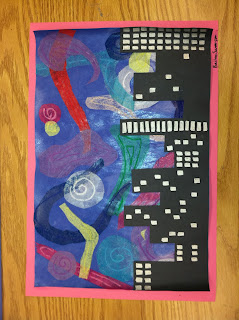On the day of the presentation, we set out the students "cave wall" canvases and also premixed all of the paint for them. We showed the students a PowerPoint, which taught them new vocabulary, history of cave painting, and also allowed them to reflect on past memories to use. The students were told to think of their favorite childhood memory and that would be what they would do their cave painting of. Next, we demonstrated how to finger paint on the brown bag with the mud paint. Students seemed to understand the technique and so we let them start on the projects. While walking around during work time, I realized that the students seemed to be enjoying their work. They were thinking of good memories and doing art at the same time. I also thought it was wonderful that I got to learn more about my students through the stories they told. Once the students had completed their work, they were told to put them in the drying rack. The students were also asked to fill out their rubrics for the project. Once everyone was cleaned up, they were told to go with a partner and discuss the questions on the reflection sheet that they were given. The following questions were asked:
- How did you create your cave painting?
- How did you feel while making your cave painting? Did you feel happy, sad, excited,...?
- What other element did you chose? Why?
- Why did you choose to paint this? What inspired your cave painting?
Once the students finished answering the questions, the lesson was complete. After the students had turned in all of their projects and reflection sheets, we graded their work based on the rubric. We then hung them up on our bulletin board. The following pictures are of my example for this project and our finished bulletin board.

















